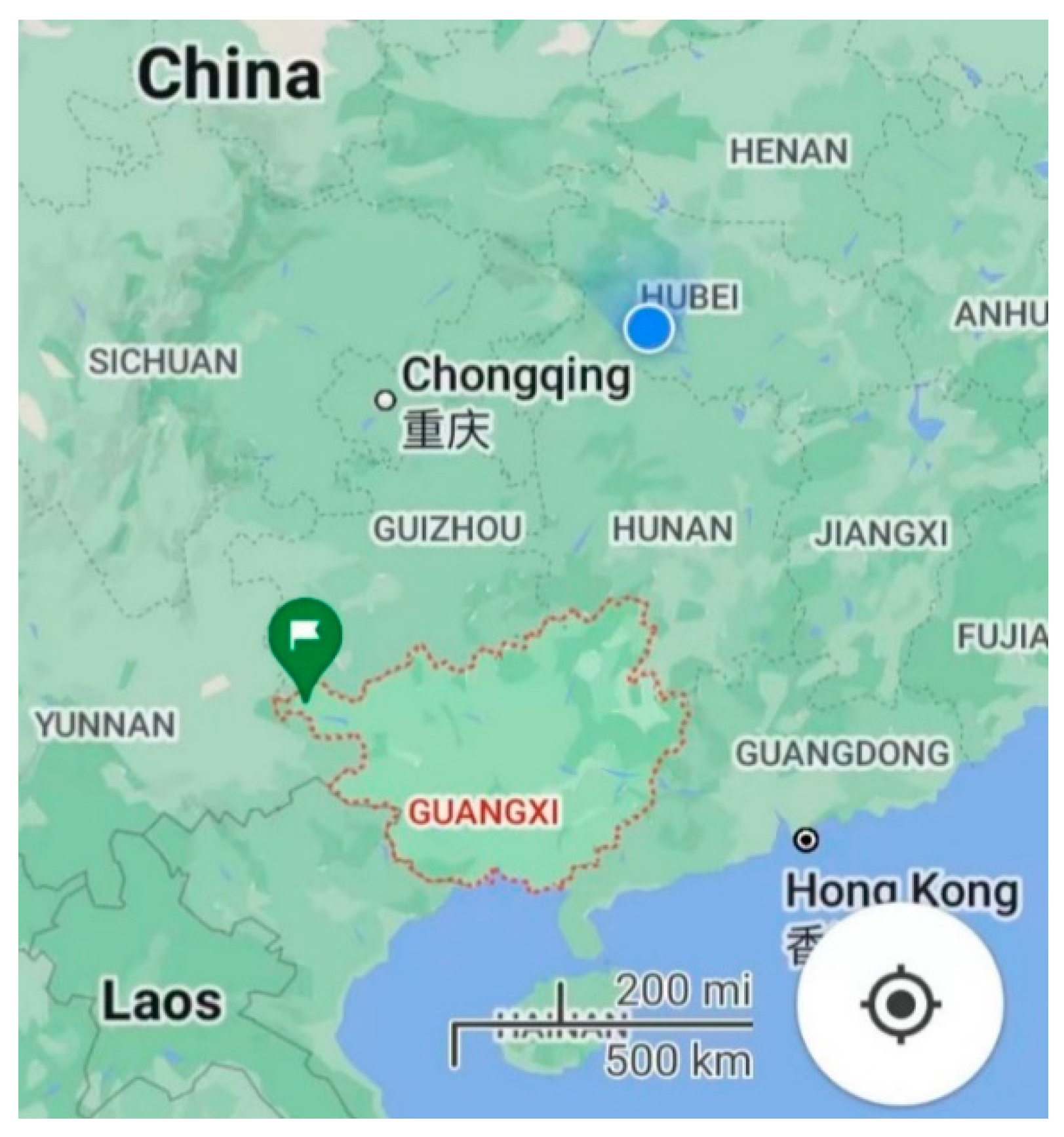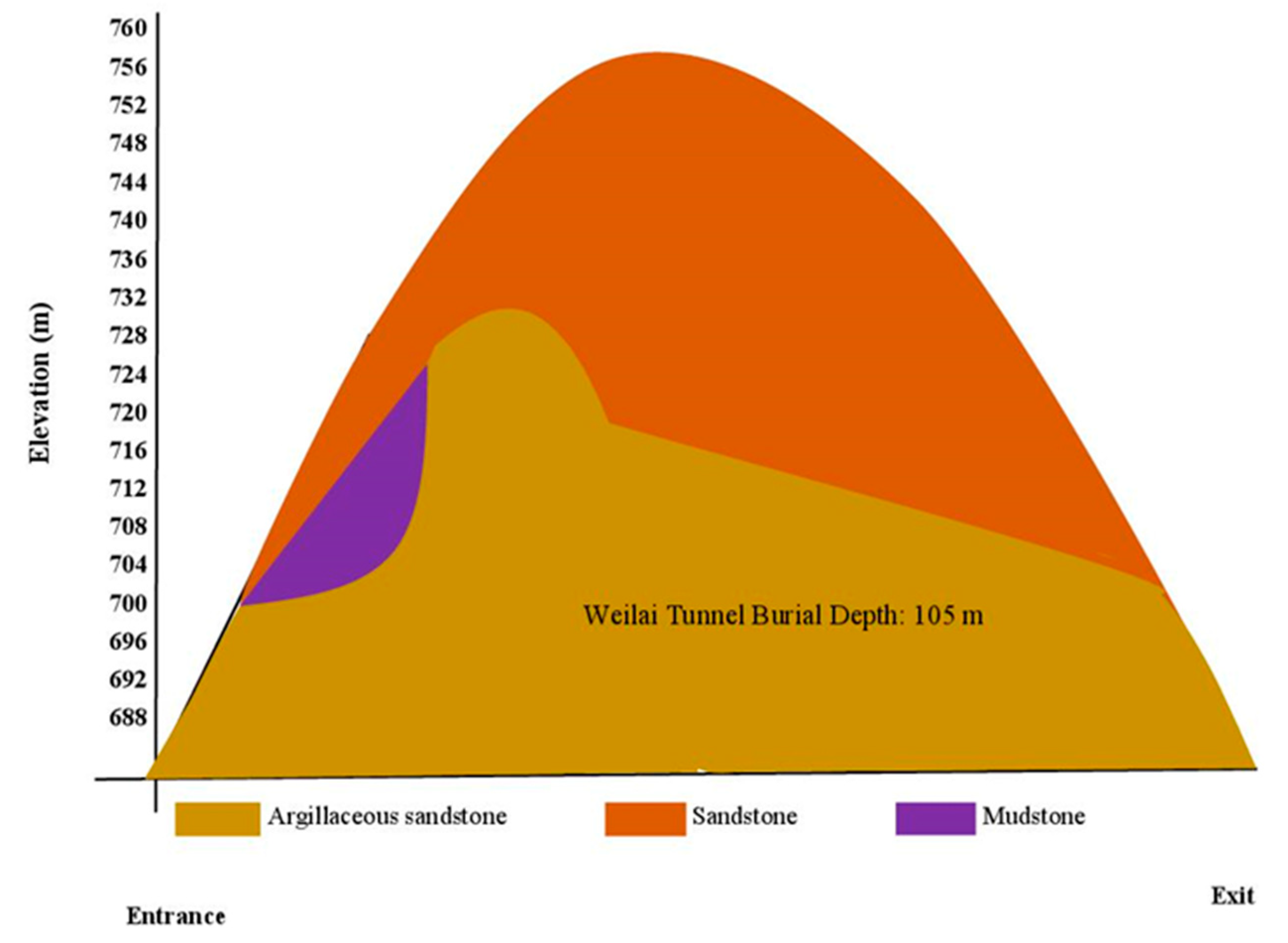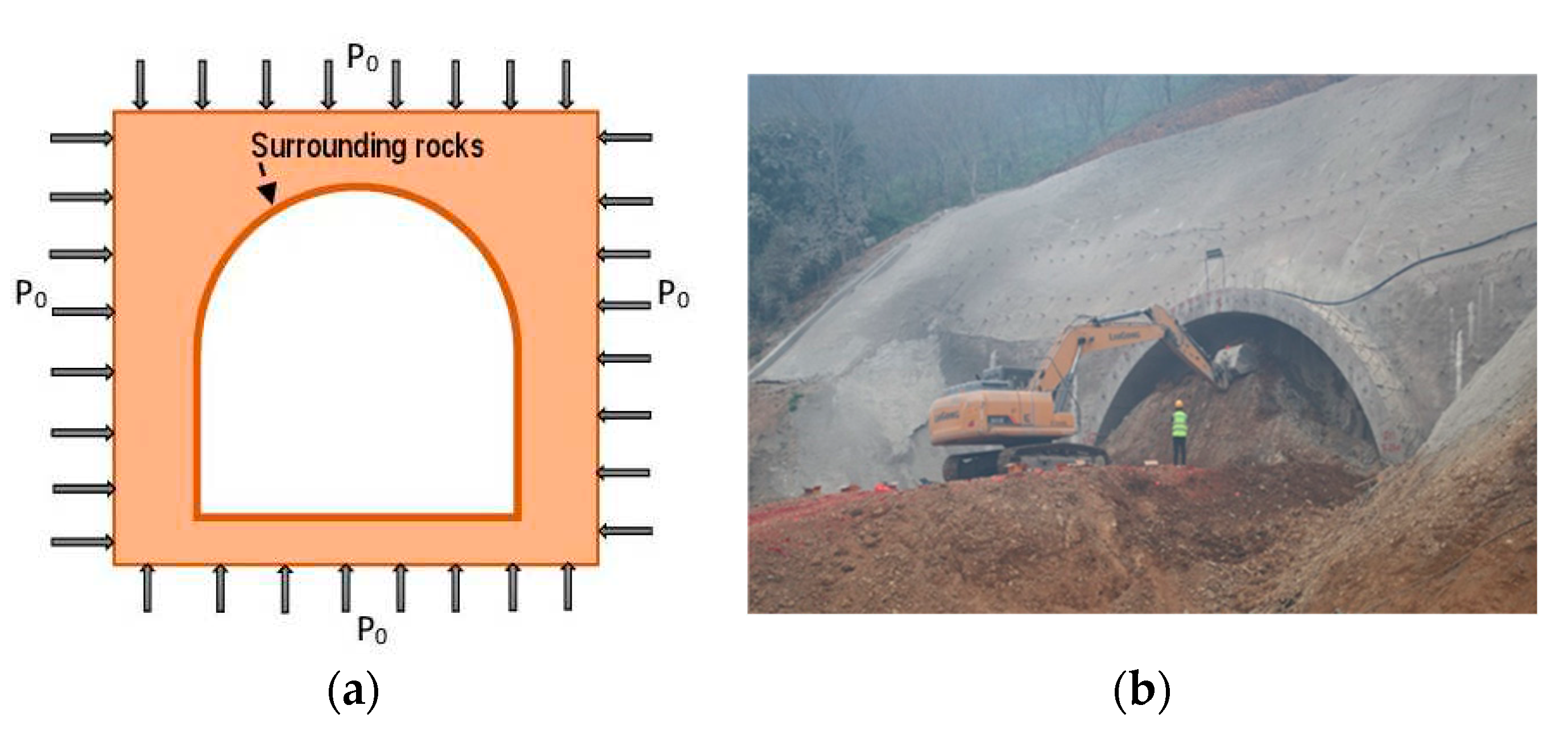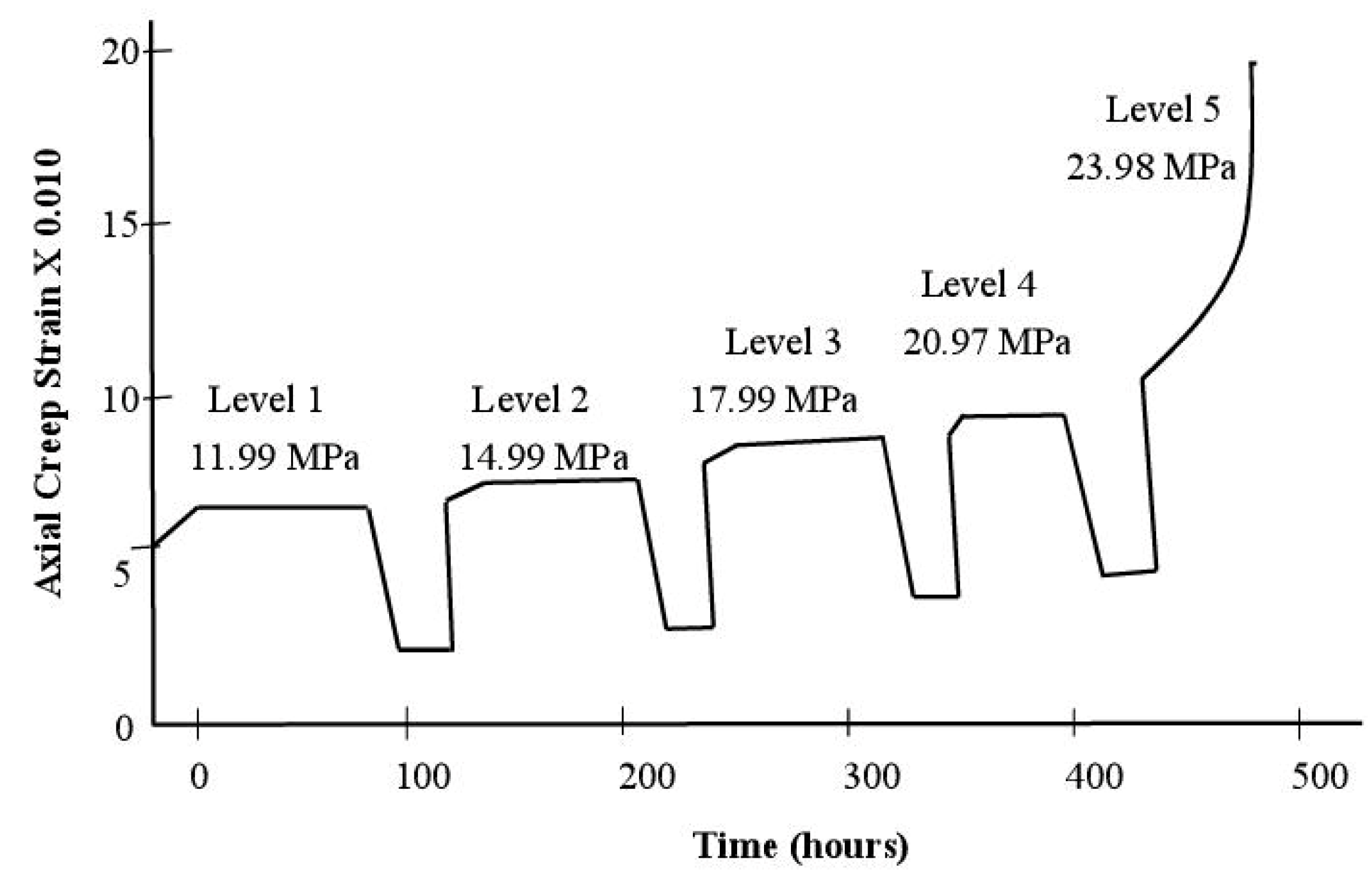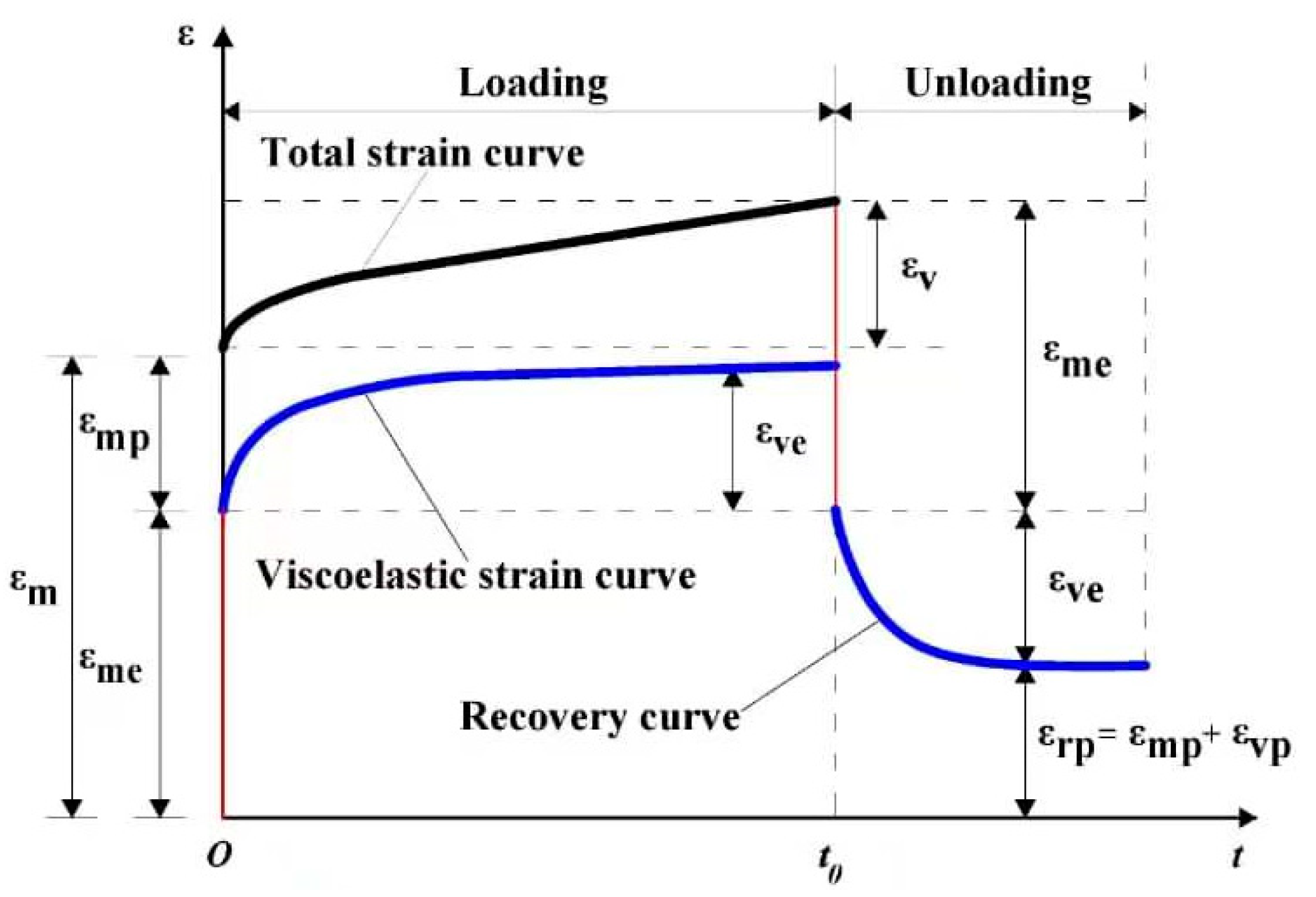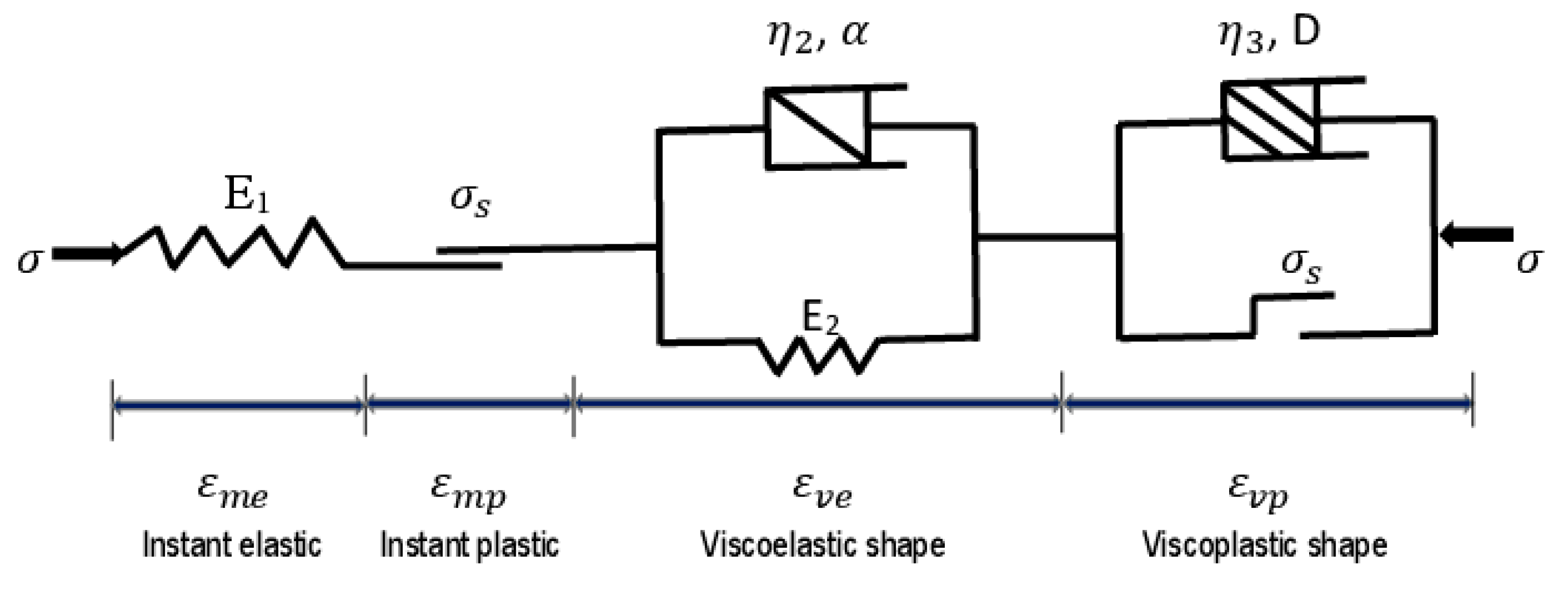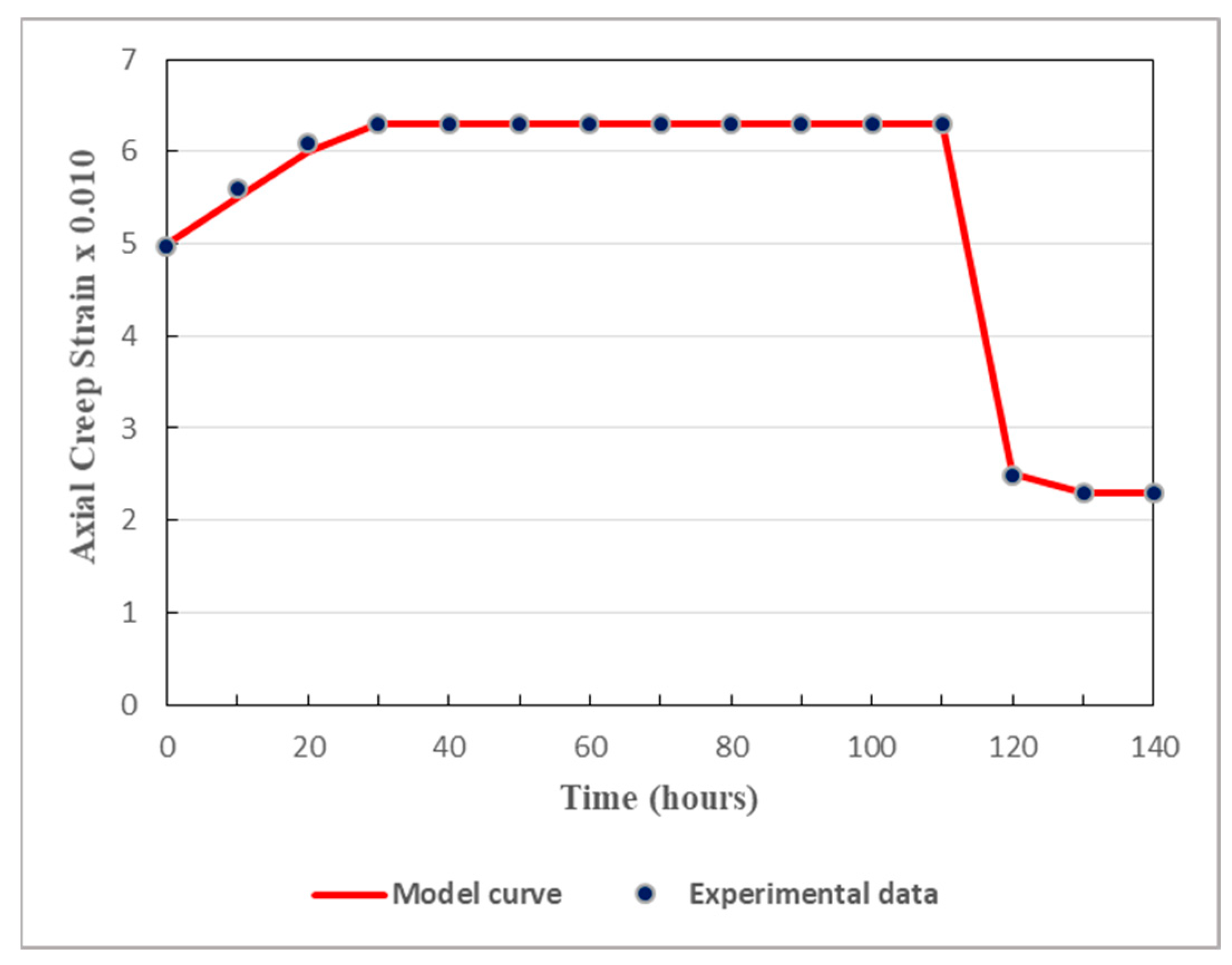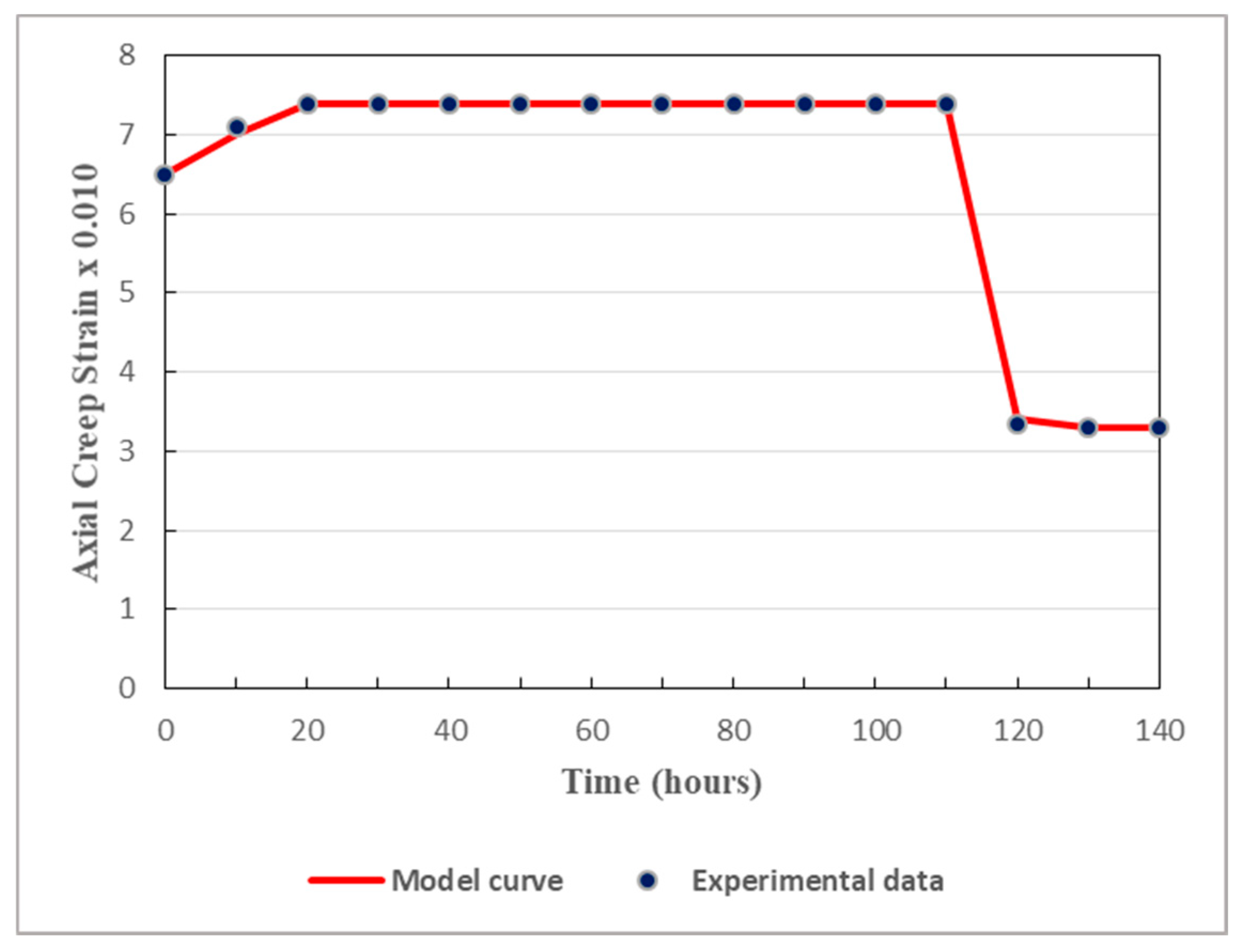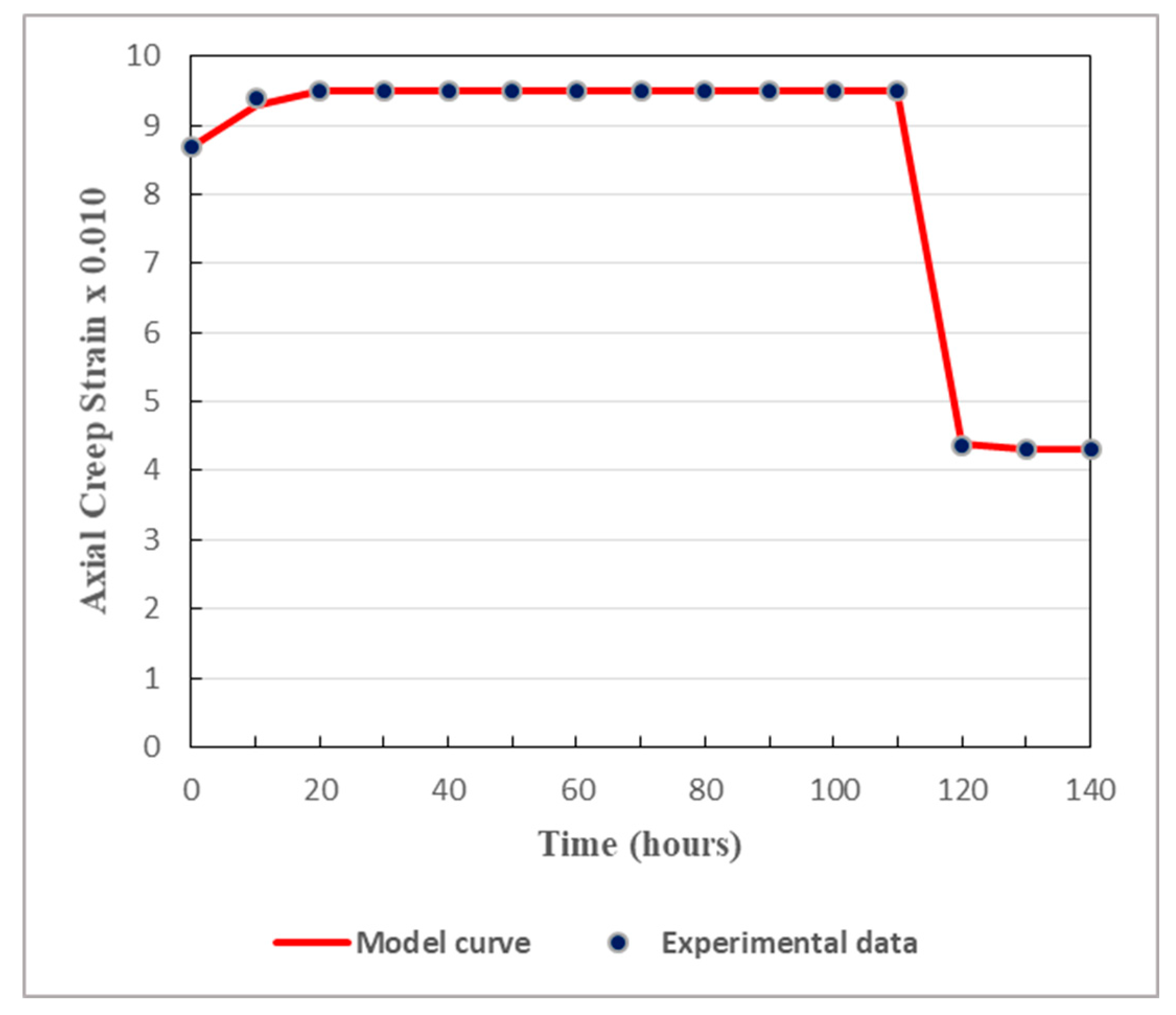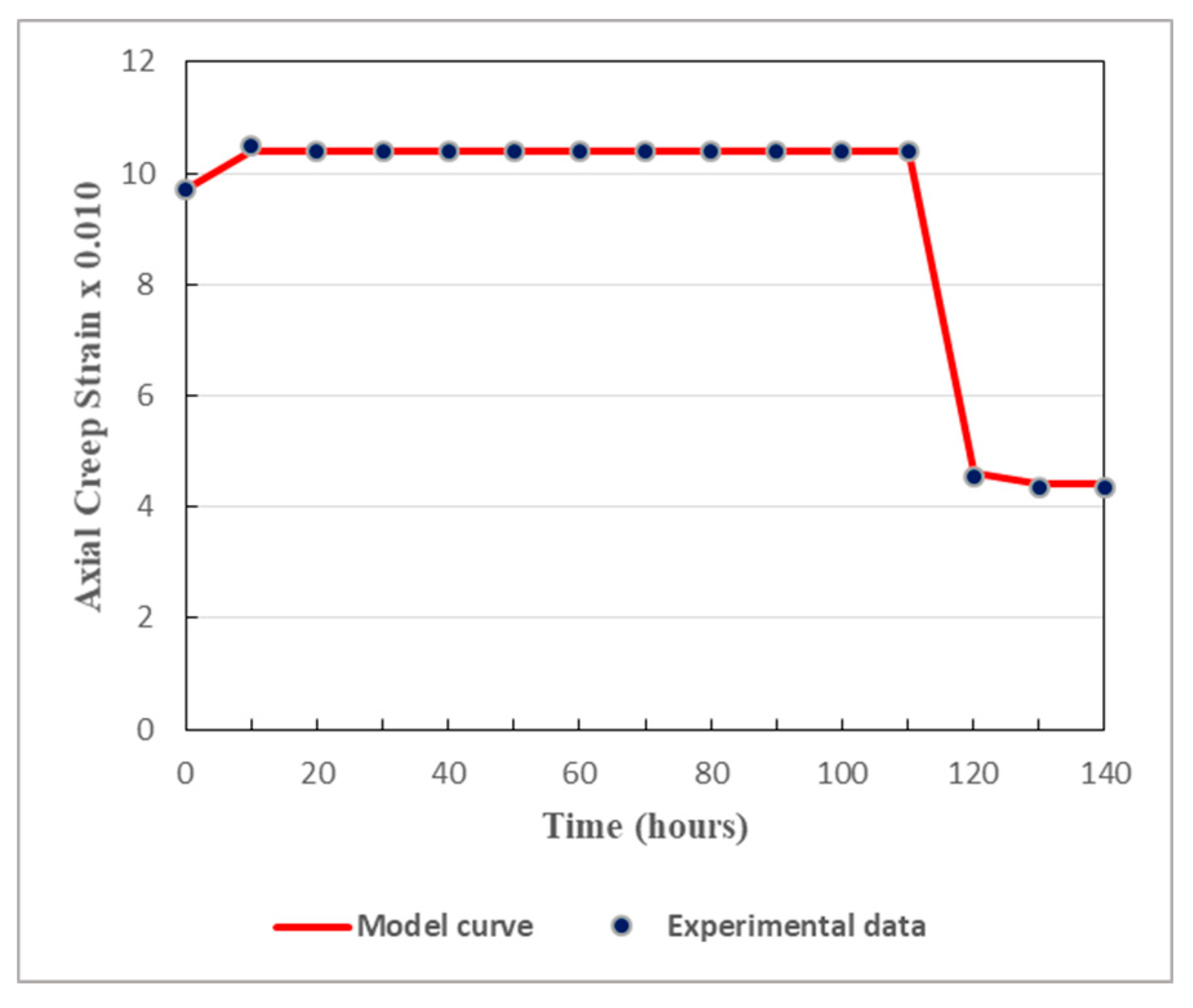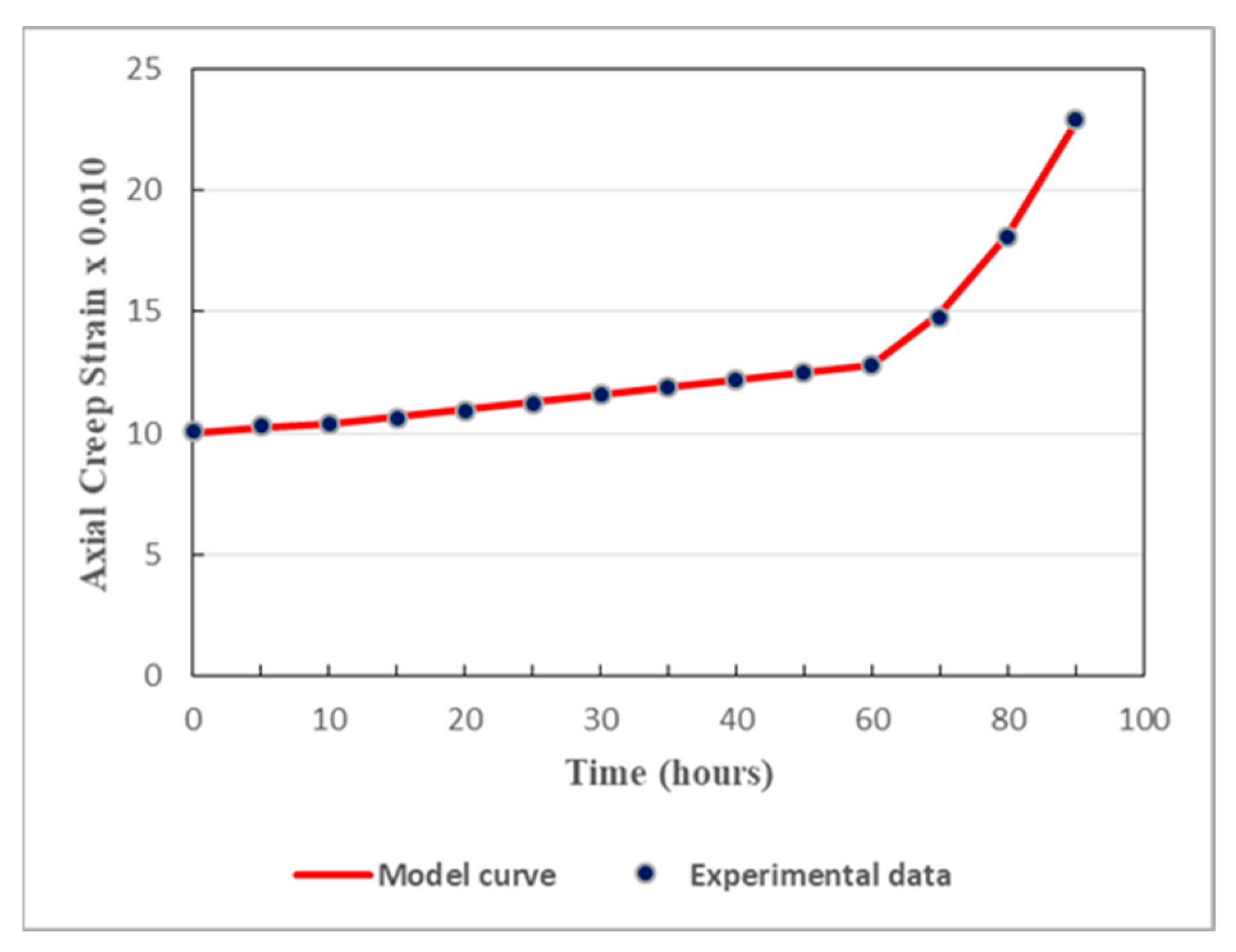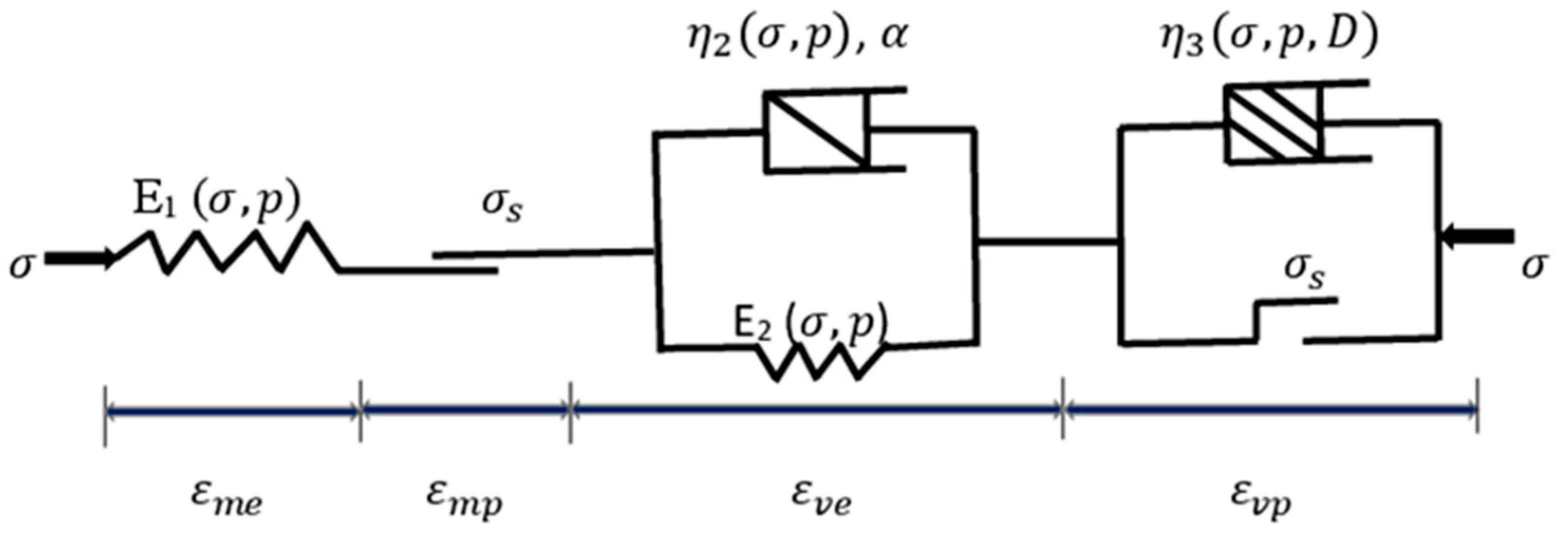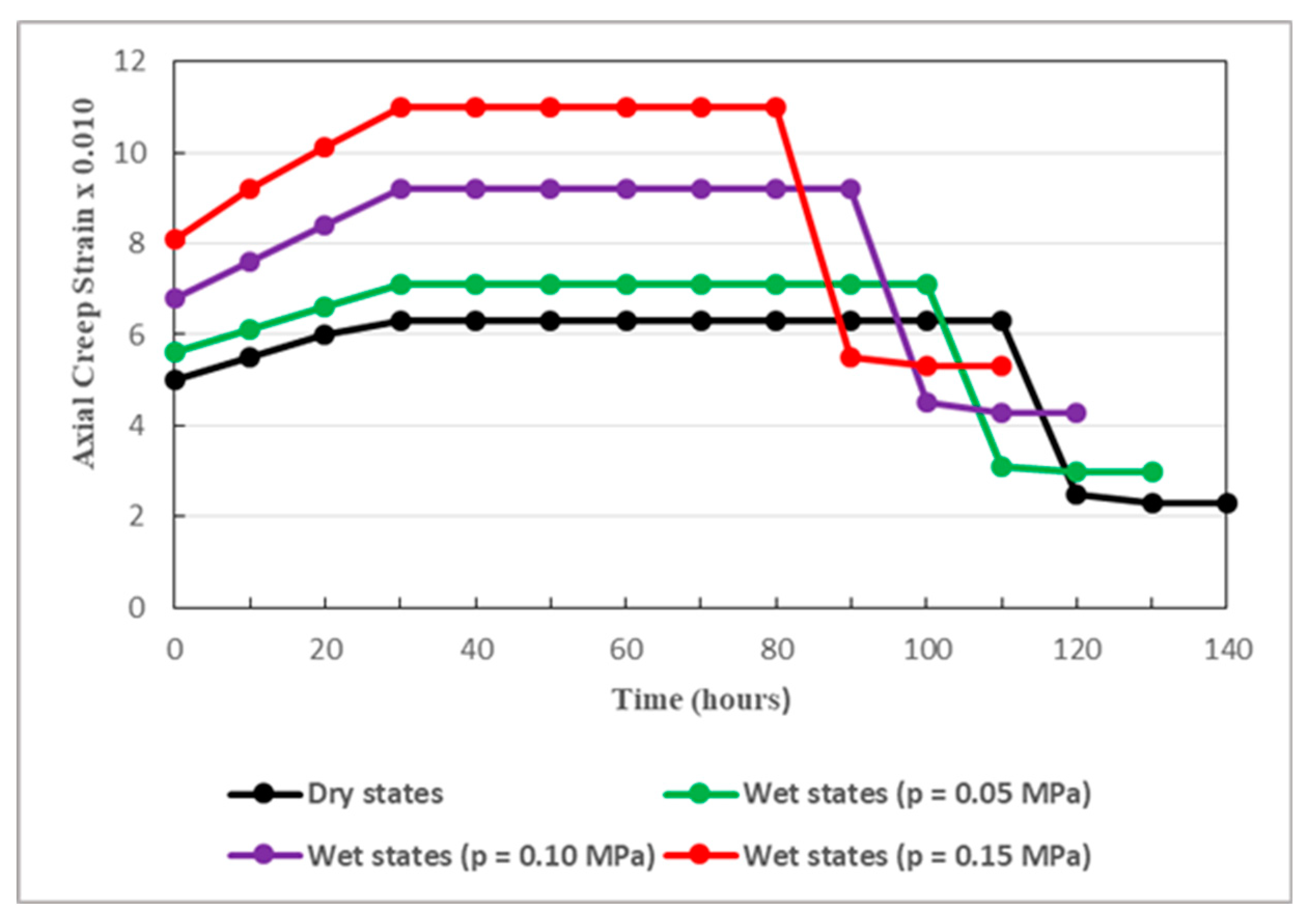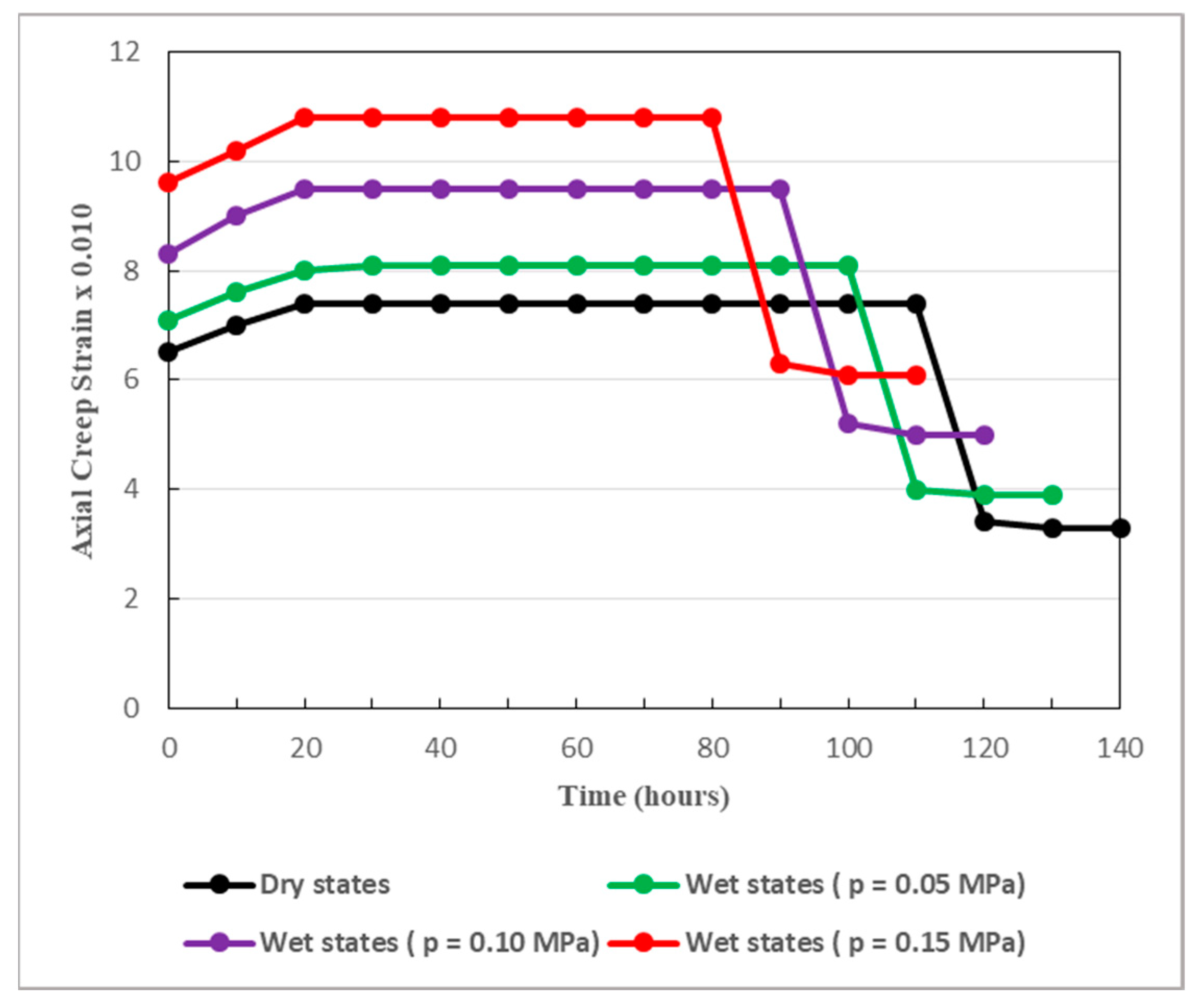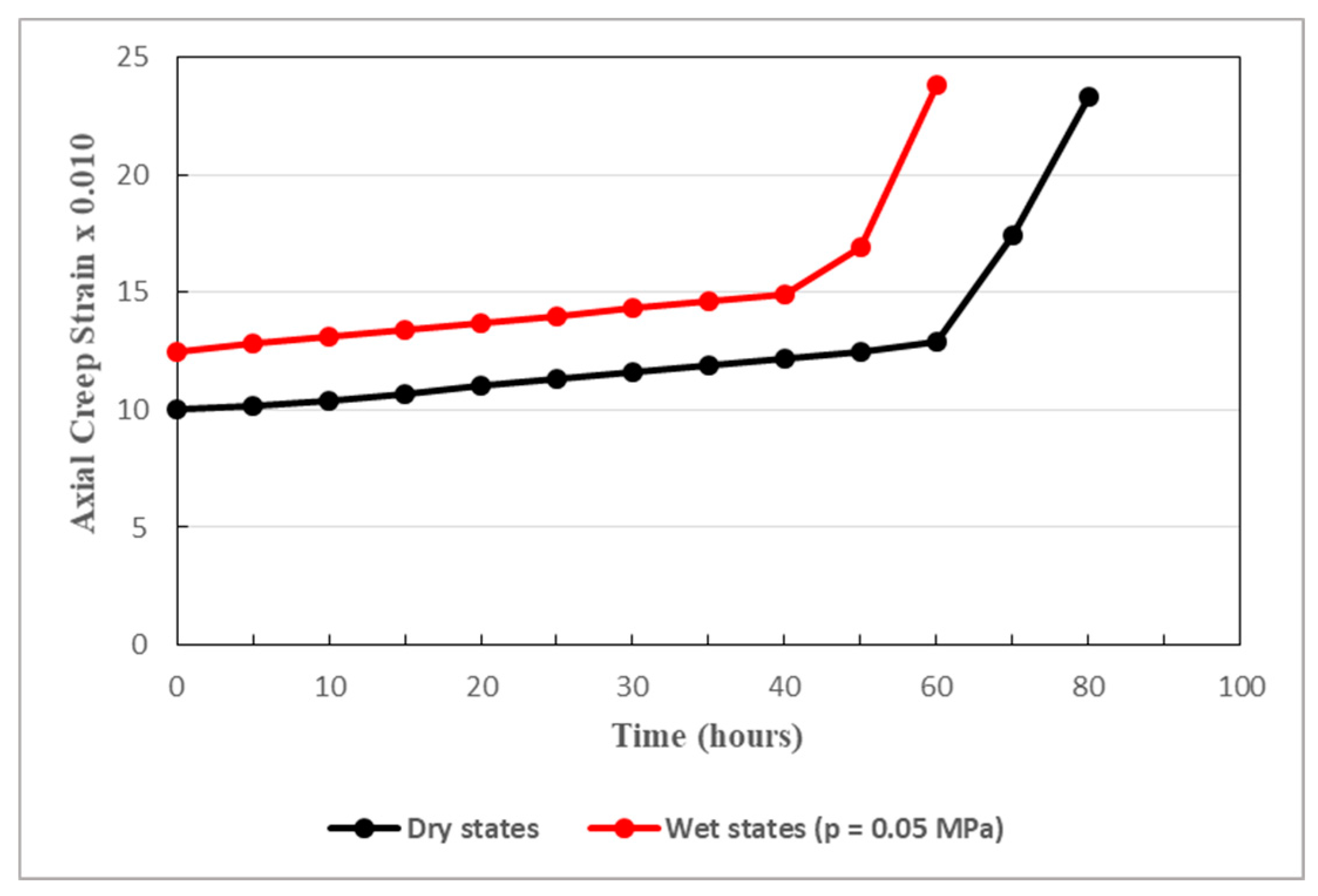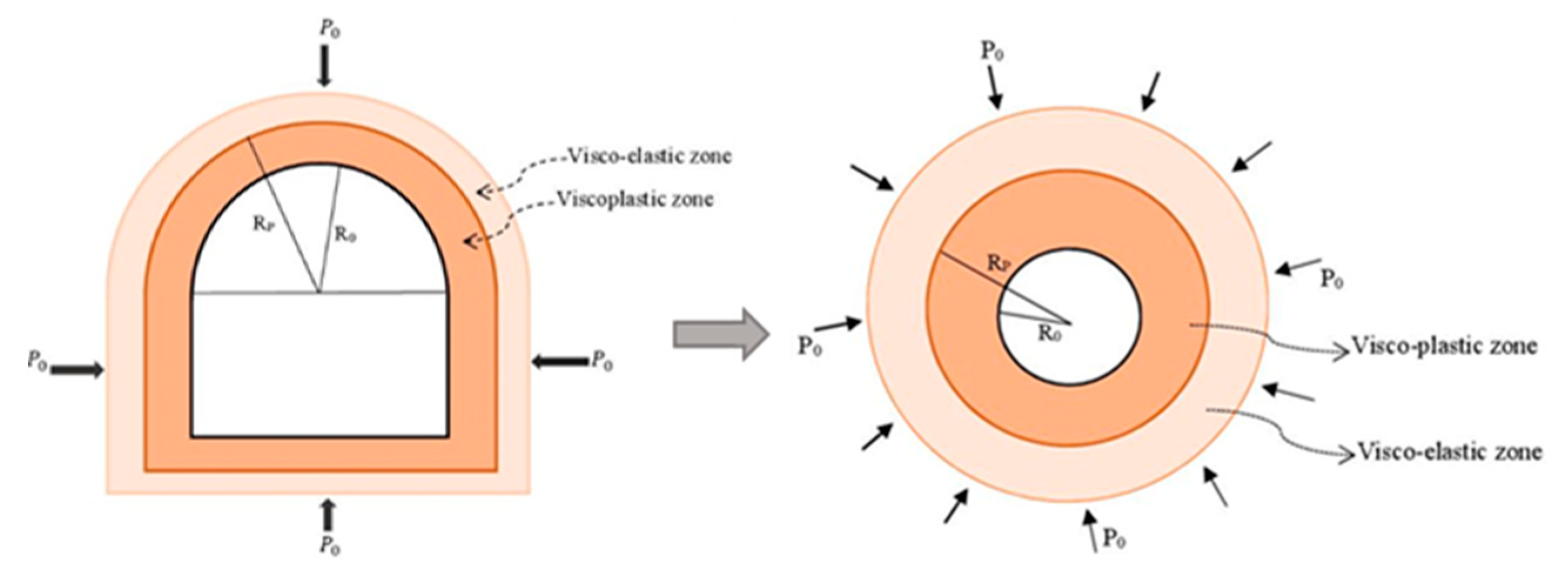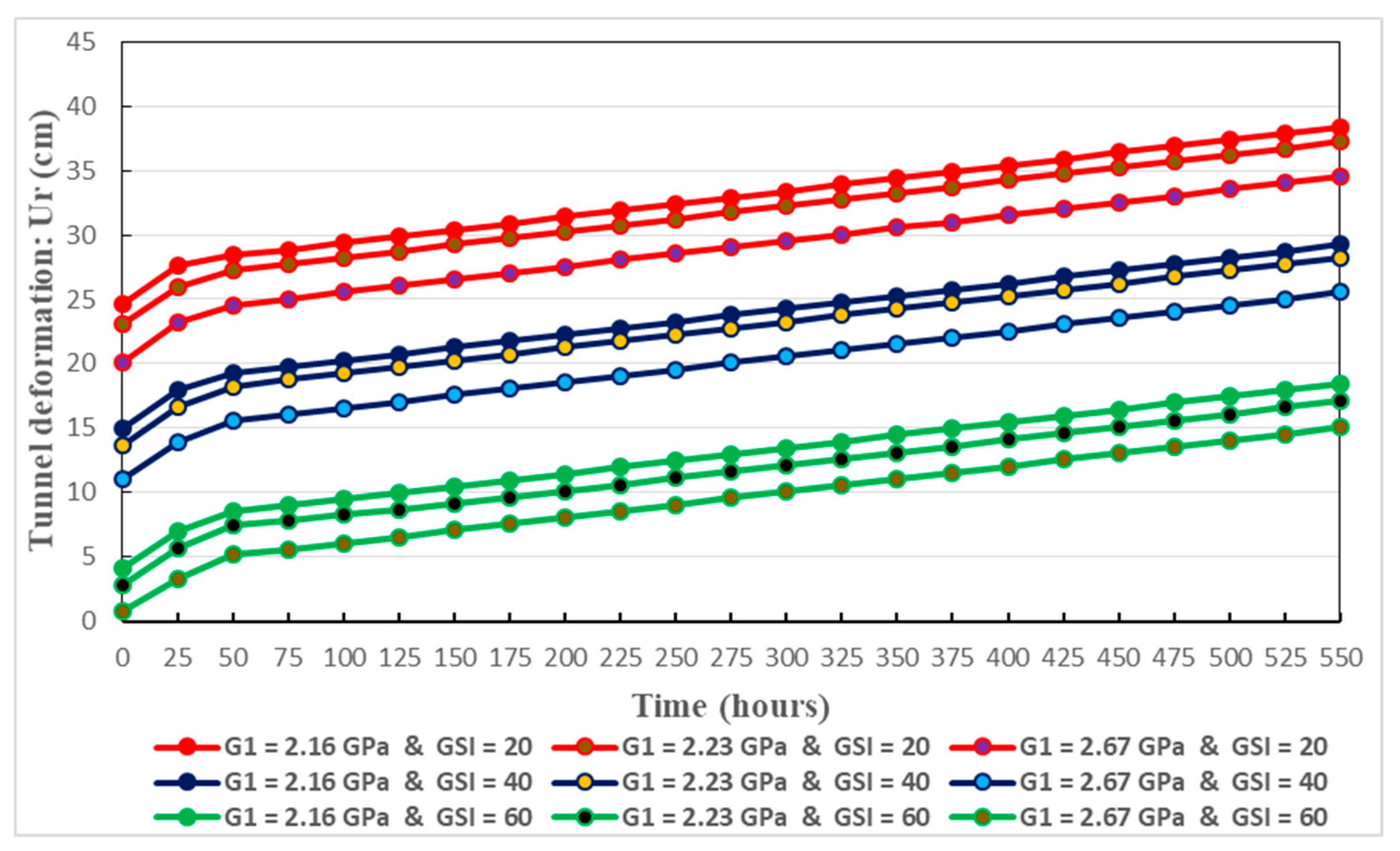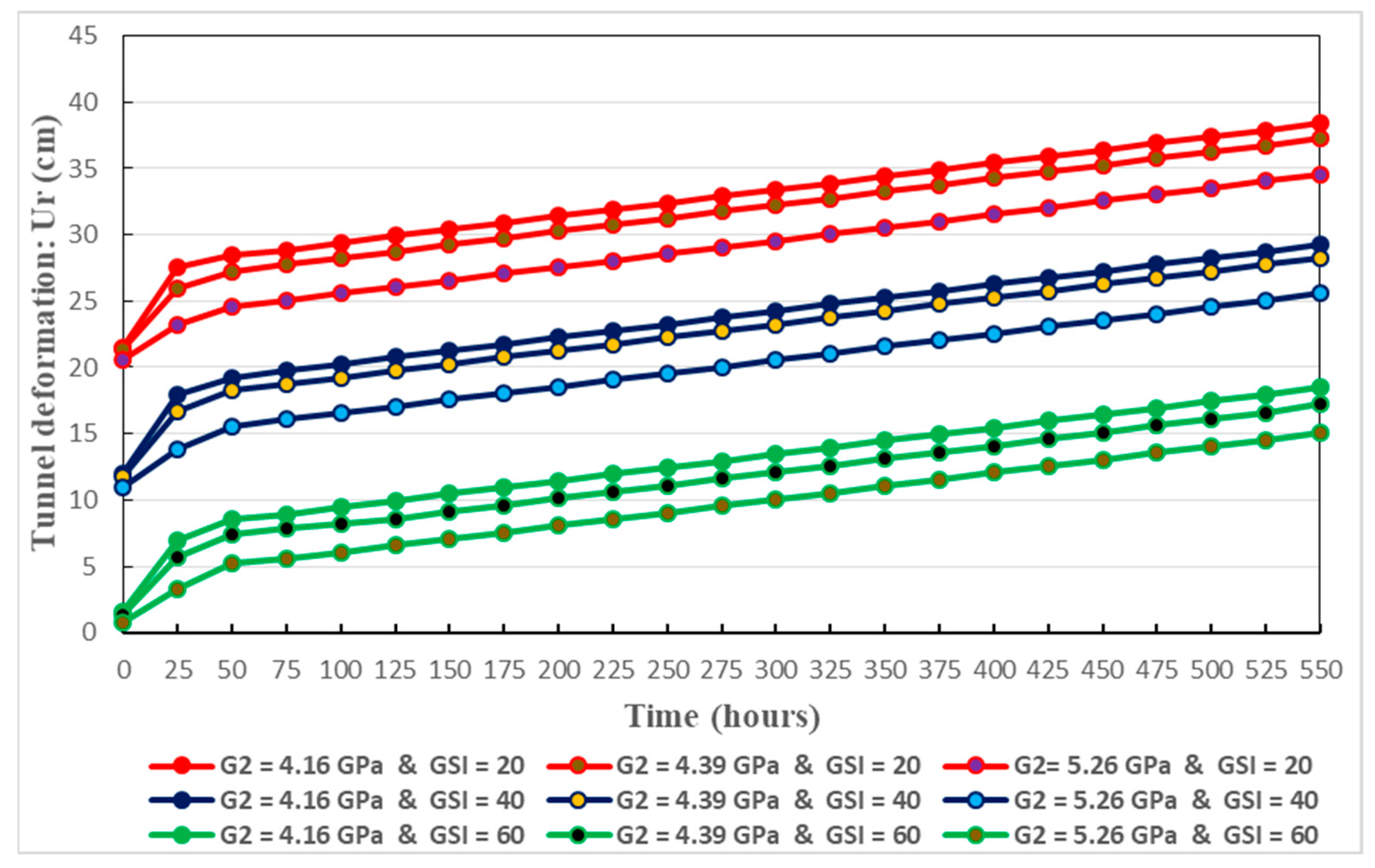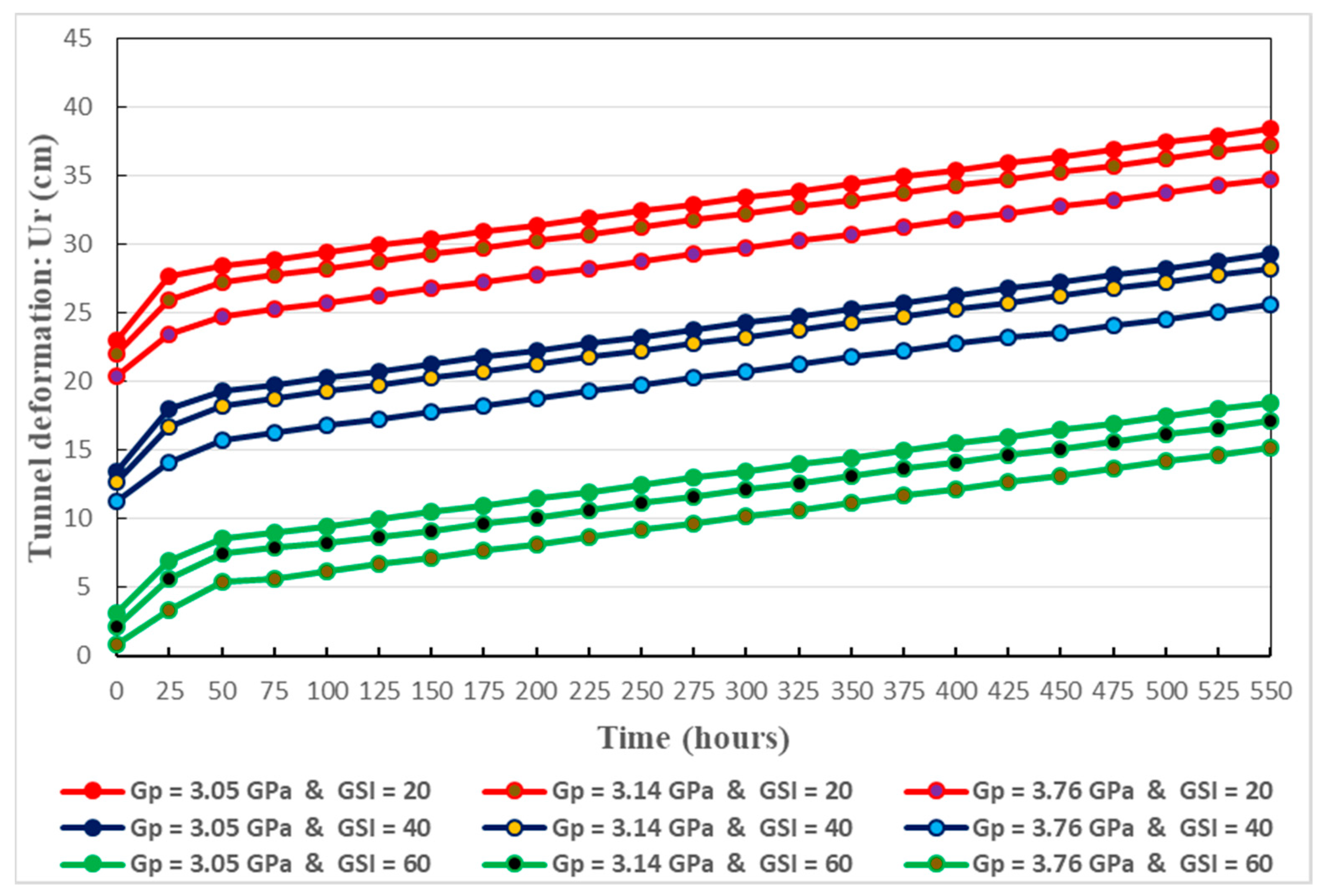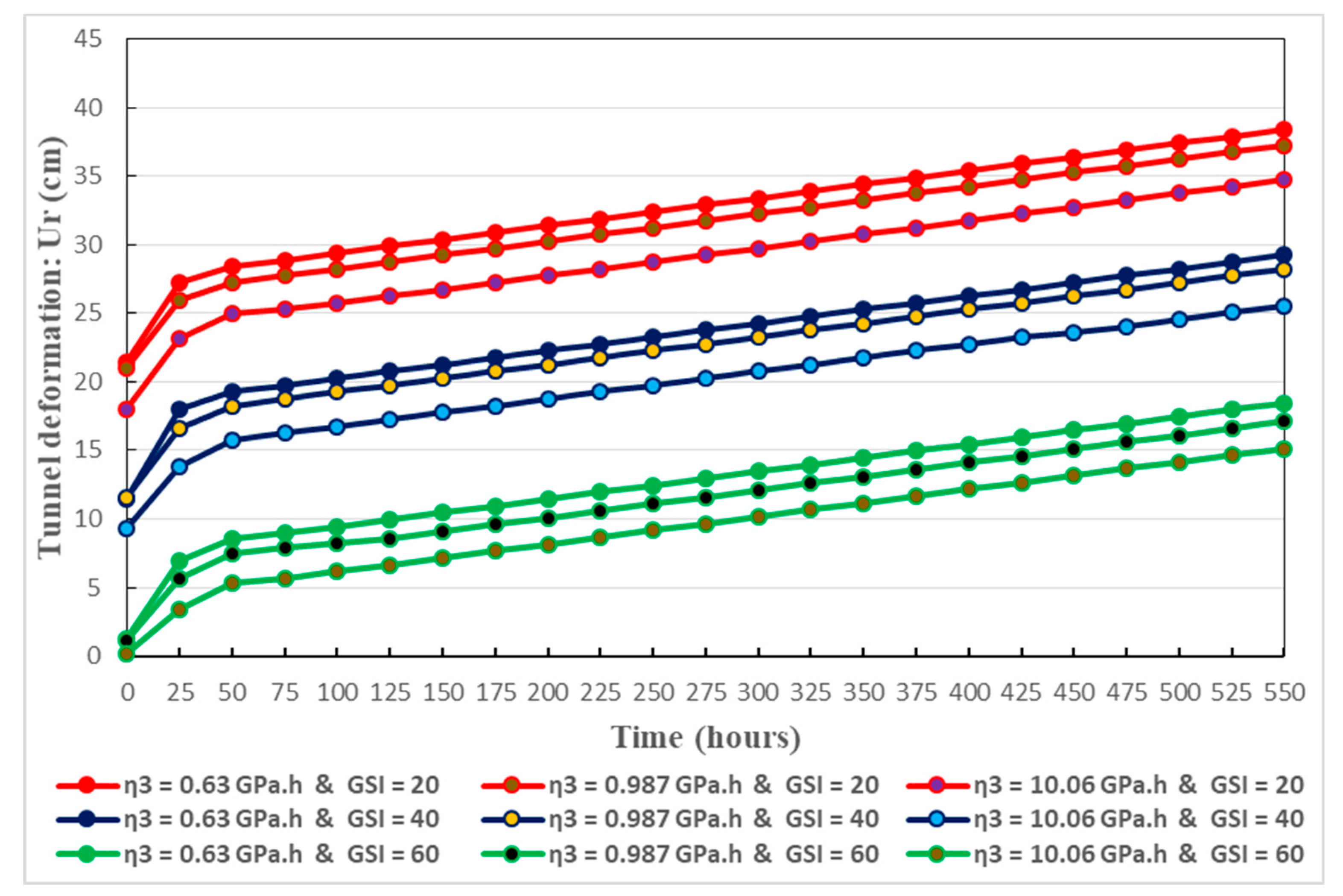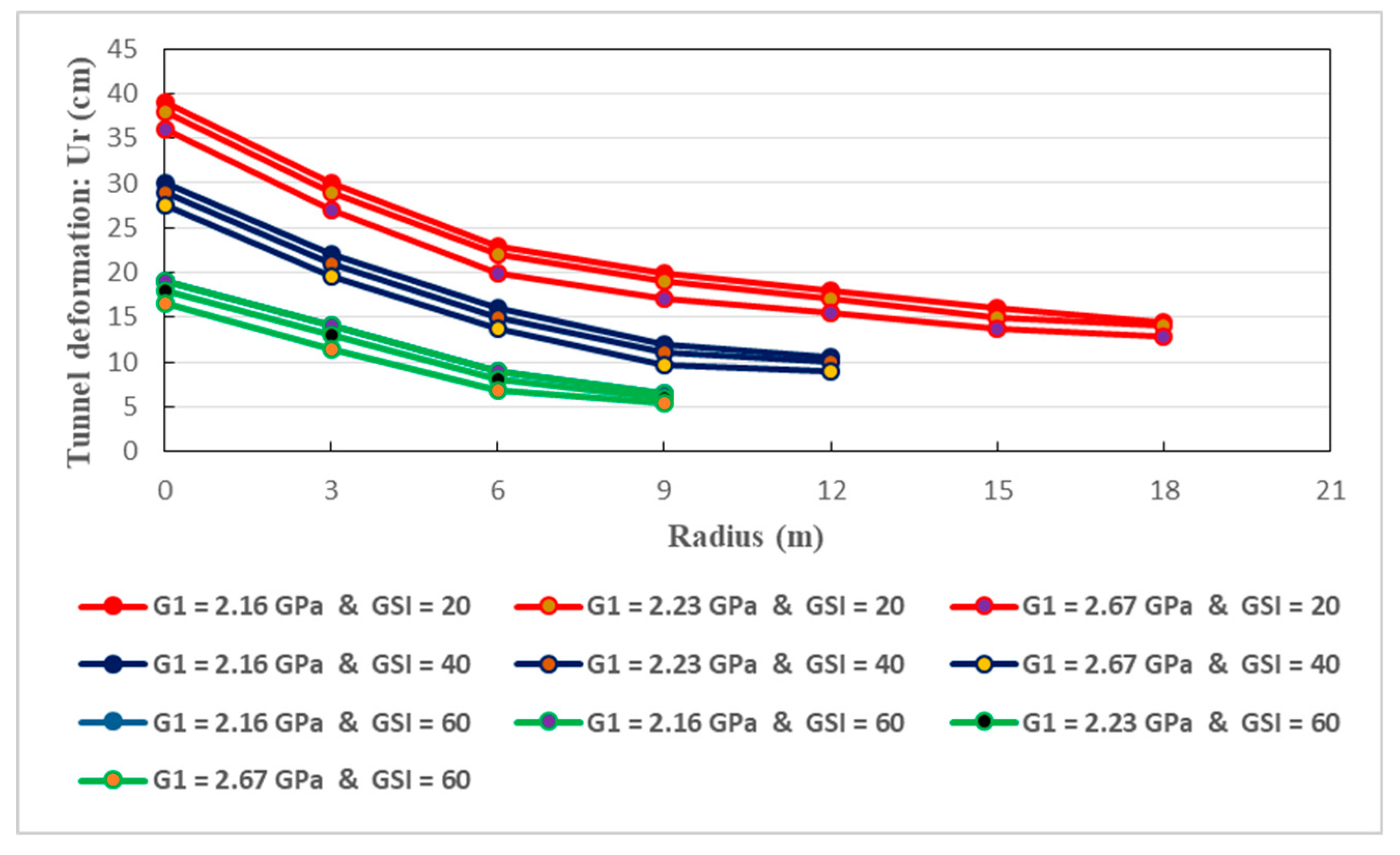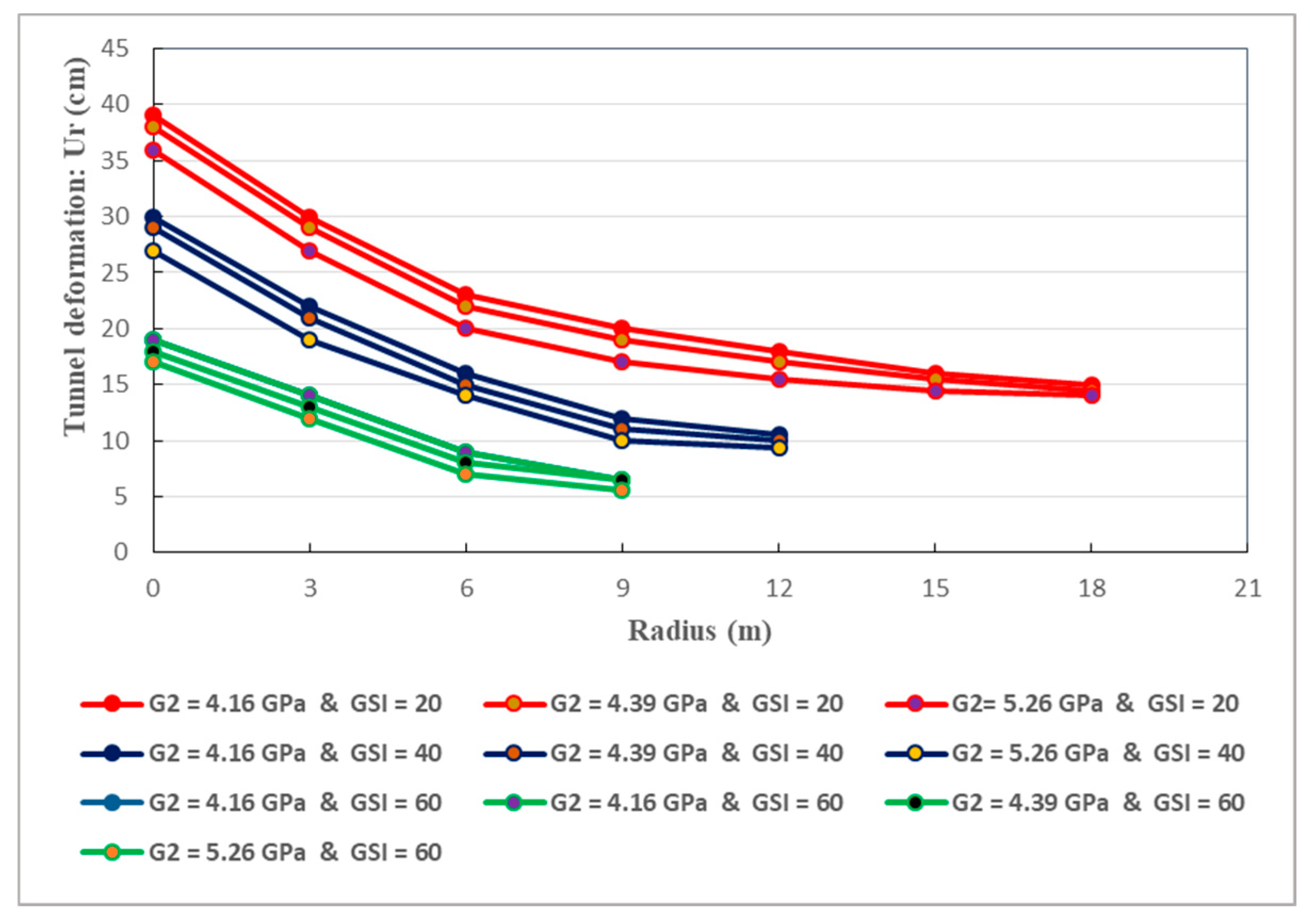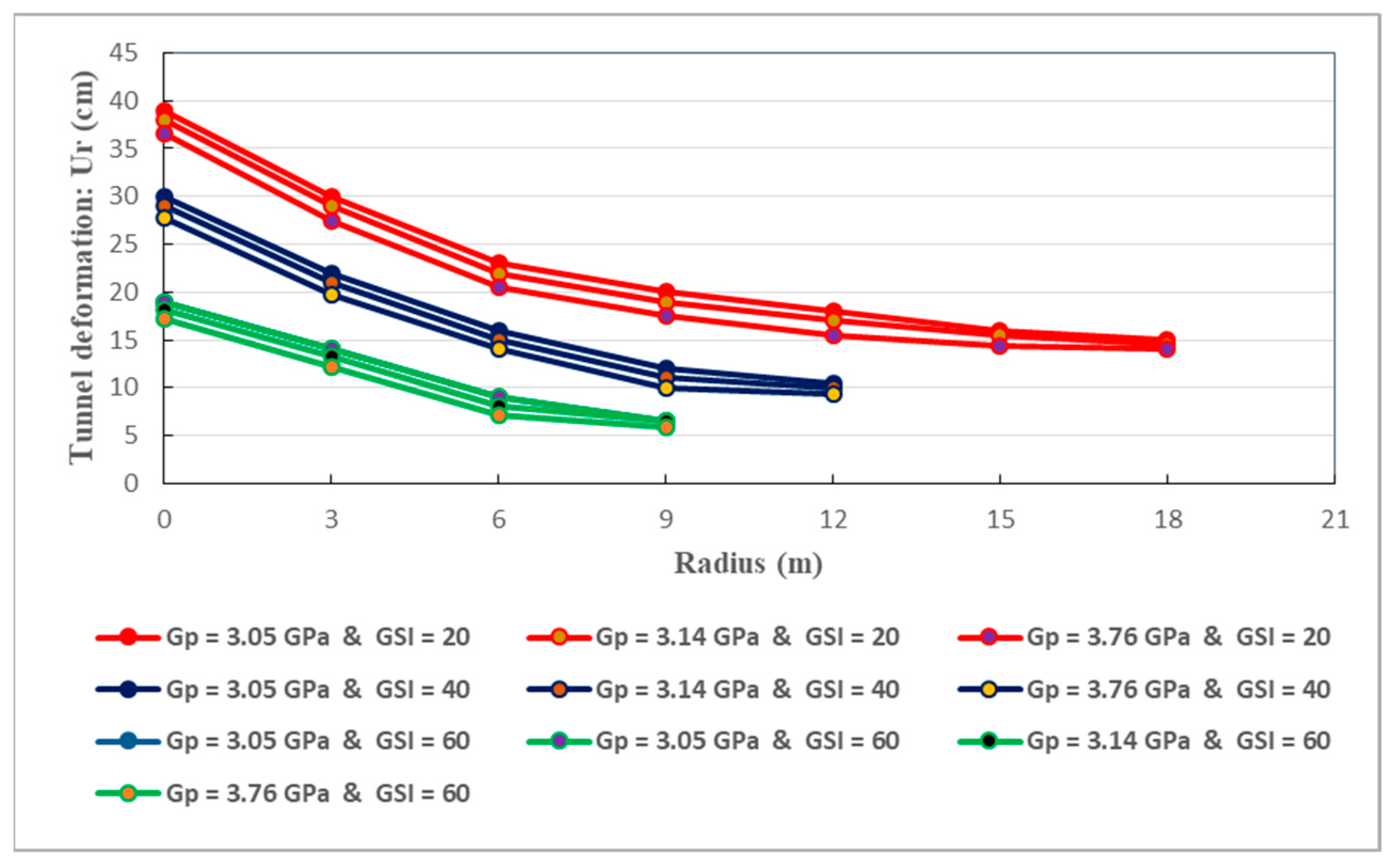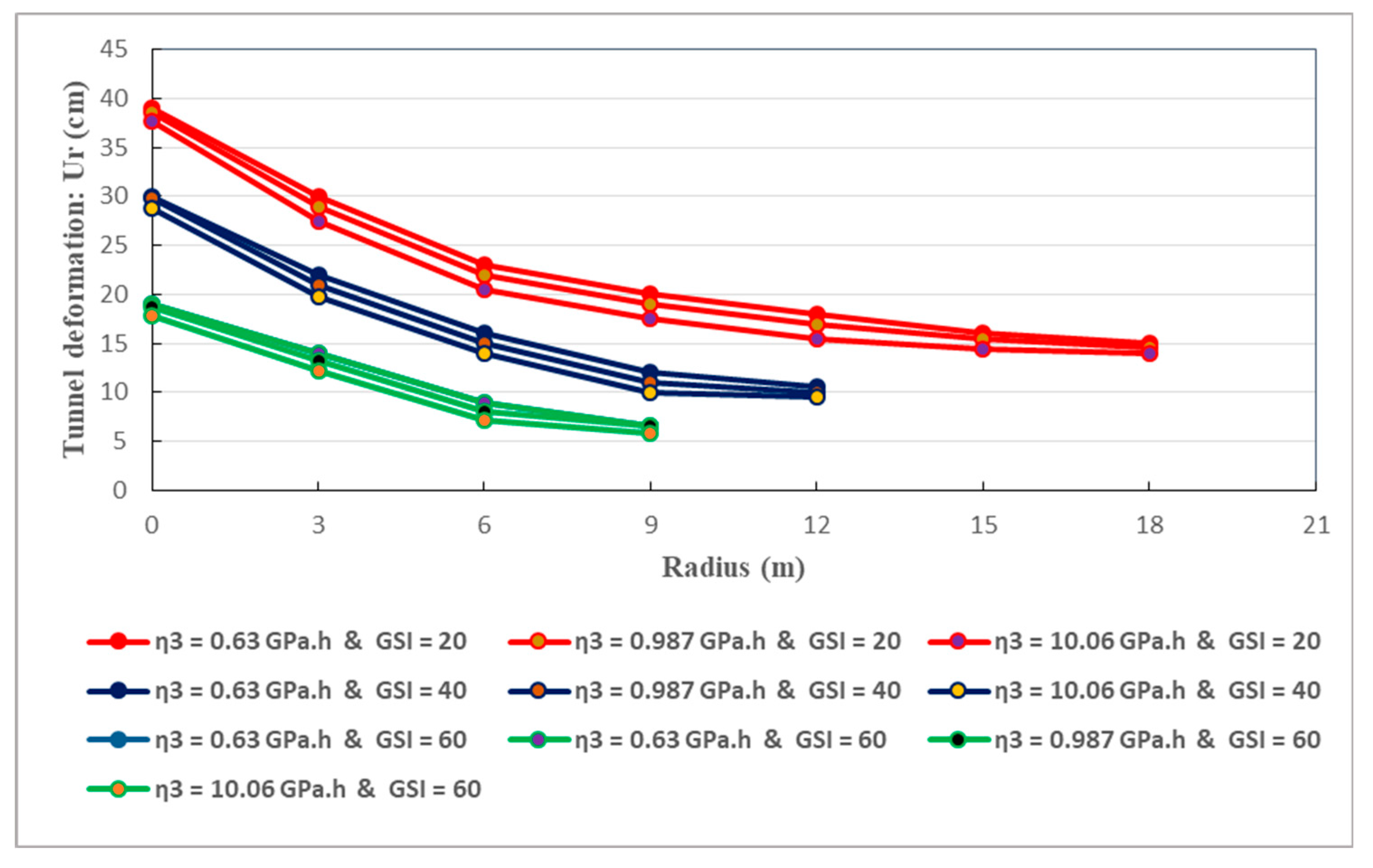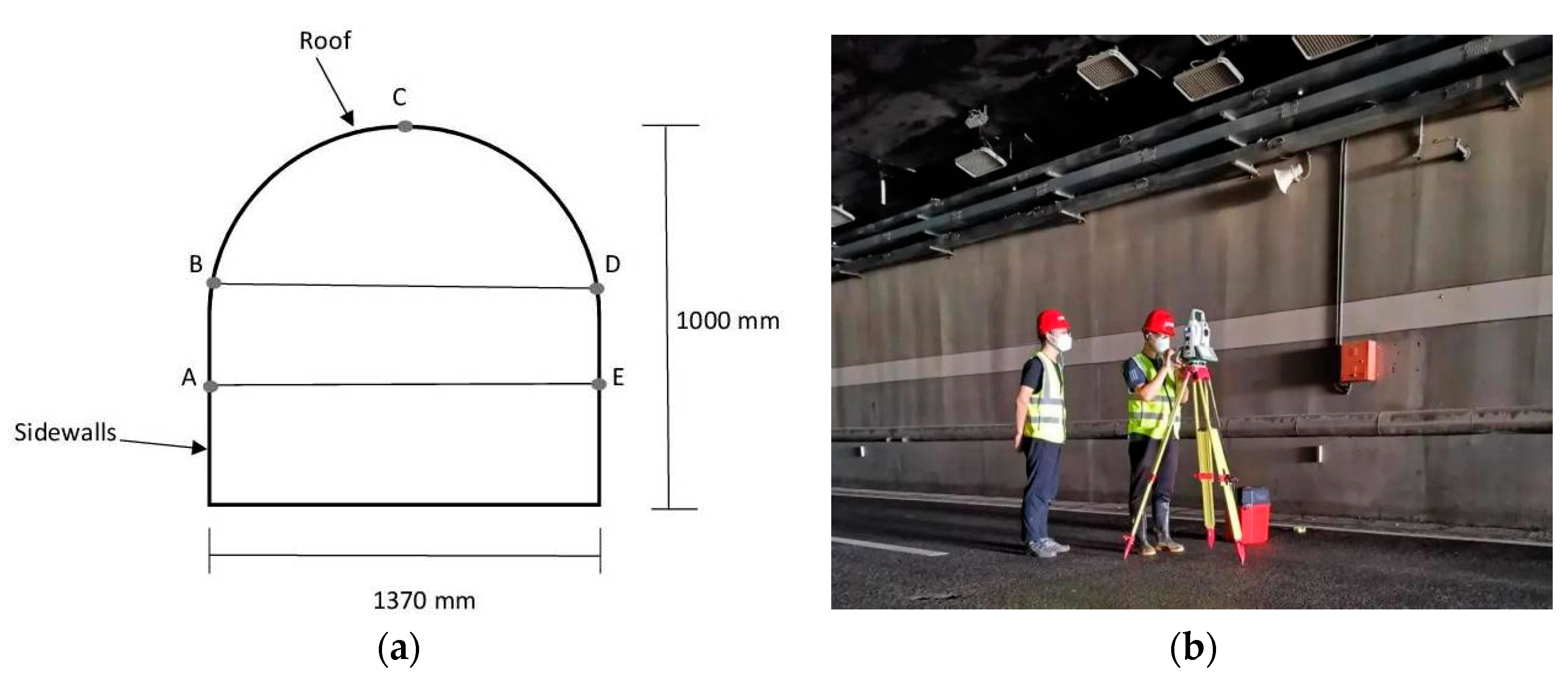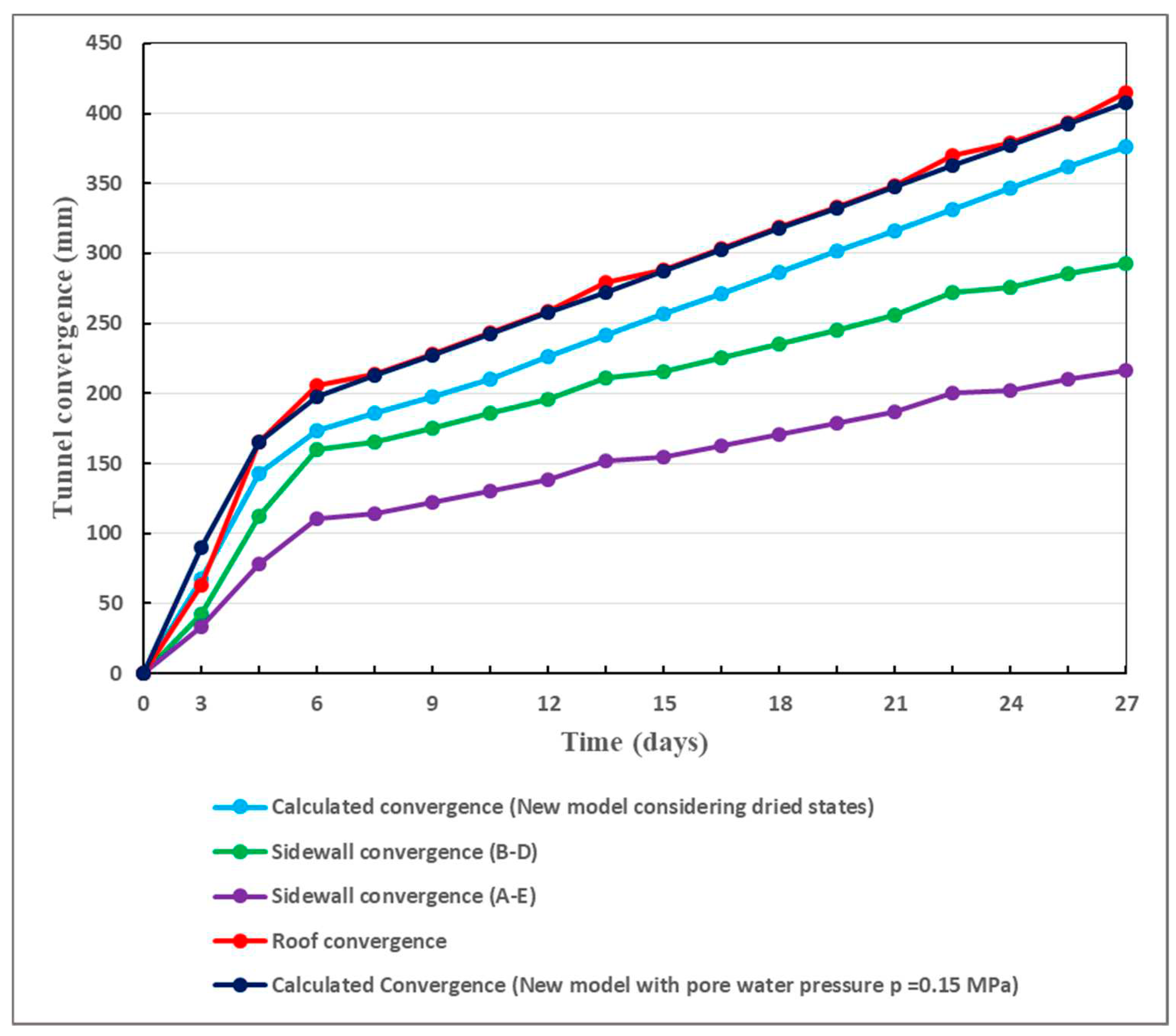Conceiving the most appropriate constitutive relationship, able to correctly reflect the comportment of the host rocks, is a major task for addressing the long-term stability of deeply buried tunnels. To this end, mechanical models which are based on rheological approach, are largely utilized. Basically, springs, dashpots and frictional-cohesive elements are constituents of a given mechanical model [
4,
24,
25]. A novel visco-elastic-plastic creep model that can be well exploited to study the long-term stability of the Weilai tunnel is of primary consideration. In fact, elasticity, plasticity, viscoelasticity and viscoplasticity coexist around the rheological deformation of rocks [
26]. It is of tremendous importance to take into consideration such rock features in the design of a novel creep constitutive.
3.3. Development of the Proposed Creep Constitutive Model
To simulate the instant elastic strain, the Hooke element is taken into account. Thereby, the axial instantaneous elastic strain can be read as follows [
29,
31]:
Here the applied stress is represented by , and the elastic modulus by .
Regarding the axial instant plastic strain, referring to Sterpi and Gioda [
32], it can be formulated by considering the modulus of the plastic deformation of the St. Venant element,
, and the scalar function,
, as follows:
The scalar function is defined as below:
Here
represents the long-term strength of rocks. Note that the long-term strength of rocks is of particular importance. In fact, due to aging and fatigue, rock strength diminishes with the passage of time [
33]. In general, the instant rock strength is typically greater than the long-term strength. For soft rocks, the long-term strength is nearly ranged from 70%-80% of the instant value [
33,
34].
Concerning the visco-elastic element, it can be simulated by the non-linear Kelvin shape [
35]. Assuming a constant
(material constant) can well reflect the inevitable influence of the stress level on rock creep, the nonlinear variant of the Kelvin model can be written in its differential constitutive equations as follows:
Here
is the applied stress,
stands for the elastic modulus of the Kelvin shape,
represents viscous coefficient of the Kelvin shape,
is the creep time. The integration of the previous equation can lead to the following:
For the viscoplastic body, it can be described by improving the Ramberg-Osgood equation. Indeed, to improve the Ramberg-Osgood equation [
36], in particular its plastic component, one considers the basic definition of rock creep where strain evolves with time, and under constant stress. Thereby, the visco-plastic creep strain model of soft rock can be written as follows:
Where and represent constant related to rock materials; denotes the applied stress; is creep time; stands for coefficient of the initial viscosity of the viscoplastic body.
The variable damage (
) is introduced since it is of primary consideration at this stage. It should be noted that, under sustained effects of deviatoric stress, the evolution of damage in rock materials is unavoidable and one of the parameters which is affected by damage is the viscosity coefficient. Hence, the damaged viscosity coefficient can be expressed as below:
Combining Equations (7) and (8), the visco-plastic creep strain can be expressed as follows:
At the tertiary creep stage, as related by [
37,
38], the evolution of damage in rock materials can be widely expressed as follows:
Here and are constants related to the materials. Under the evolution of time, critical or full scope of damage generally causes rock failure. Therefore, it is important to take into account the time-to-failure.
By solving the Equation (10) and by considering that
, where
represents the rock time-to-failure, we can obtain the following:
Afterwards, the combination of equations (10) and (11) leads to the expression of the damage variable as below:
Combining Equations (9) and (12), the visco-plastic creep strain can be expressed as follows:
In its one dimension form, the novel creep model can be written as:
The three-dimensional form of the proposed creep model can be built by considering that rocks are typically in three-dimensional stress states. One assumes that creep is mainly provoked by the deviatoric stress tensor (), damage is accounted at the tertiary creep phase, and the Poisson’s ratio of the rocks is not affected by time. The stress tensor () is mainly composed of the deviatoric stress tensor () and the spherical tensor ().
On the basis of Hooke’s law, the deviatoric stress tensor (
) and the spherical stress tensor (
) can be expressed as follows:
The shear or deviatoric strain tensor (
), and the volumetric or spherical strain invariant (
) are expressed as follows, where
stands for the Kronecker function:
The total strain (
) in three-dimensional form can be given by superimposing its components, by assuming that rocks are continuous media, as follows:
Where and represents respectively three-dimensional form of the instant elastic strain, and the visco-elastic strain; and are respectively three-dimensional form of the instant plastic strain, and visco-plastic strain.
The instant elastic strain (
) and the visco-elastic strain (
) can be three-dimensionally expressed as follows:
Here is shear modulus of elastic element; represents the tensor of stress; is instant shear modulus; is the long-term strength of rock in three-dimensional form.
Likewise, the instant plastic strain (
), and visco-plastic strain (
) can be three-dimensionally written as follows:
The three-dimensional form of the proposed model can thus be read as below:
With the variable damage D, the three-dimensional form of the proposed model can also be written as follows:
The axial stress deviator (
), for the maximum stress direction, is given by:
Thereby, in the maximum stress direction, the creep model can be computed as:
The unloading of the applied stress is assumed to be happened at time
. As such, the three-dimensional form of the proposed creep model can be converted into the following unloading equations:
3.3.1. Identification of Model Parameters
Designed to depict the creep behavior of soft rocks, the novel creep model takes into account several parameters such as elastic, plastic and viscous. The shear modulus
can be assessed as below:
Where denotes poisson’s ratio; and E elastic modulus.
To evaluate
, the experimental data related to instant plastic creep strains are employed. Concerning the determination of
and
, Equation (32) is used. Note that, under the conditions of the time
is infinitely large, and
, the aforesaid equations can be modified as follows:
Besides, under the aforementioned conditions, adequate operations are utilized. The subtraction of equation (24) into equation (27) provides the following:
Also, when
and
, we can get:
Equation (29) is a function in which
is the variable. It can be formulated as below:
A nonlinear function can describe the previous function. The general form is as follows:
Here , , and are fitting parameters.
By identifying common terms in the equations (30) and (31), we can get:
The fitting parameters can be used to evaluate
,
, and
. As such,
,
, and
can be found to be:
The nonlinear least square method of Levenberg–Marquardt [
39] is utilized to determine the viscosity coefficients
and
, and the constant of rock materials
,. For the fitting of creep test data, a typical parametric equation can be employed as below:
Here
stands for the total creep strain of the designed model; the fitting parameters are
, and
which are written as follows:
Equations (34) and (35) can be combined as follows:
3.3.2. Validation of the Proposed Model
The model is verified in good agreement with the results of creep tests under triaxial cyclic load-unload cycles. The coefficient of determination (
) is employed to check the model accuracy. Broadly speaking, the peak value of
is 1. Higher values of
correspond to higher accuracies. The coefficient of determination (
) is expressed as:
Here represents the amount of test data points; stands for calculated values; , and denotes respectively the test value and its average.
In
Table 4 and
Table 5, respectively for loading and unloading conditions, the calculated parameters of the model are presented.
In order to ensure proper validation, comparisons are made between creep strains calculated from the model and the pertinent experimental data. Under different levels of the deviatoric stress, the results are displayed in
Figure 7,
Figure 8,
Figure 9,
Figure 10 and
Figure 11.
As displayed in
Figure 7,
Figure 8,
Figure 9,
Figure 10 and
Figure 11, both in the loading stage and in the unloading stage, the model is in good agreement with the experimental data. The proposed model can thus well simulate the creep behavior of the studied tunnel. It can be remarked that there is huge difference between the values obtained from the loading stage and those obtained from the unloading stage. In fact, the unloading process has considerable effects on the mechanical properties of soft rocks. Since cracks generally tend to evolve rapidly in unloaded rocks, the rock relevant mechanical properties are affected by the unloading phase and then altered to some extent. It should be noted that, generally, soft rocks have lesser abilities to withstand deformations generated by the unloading stage than those caused by the loading stage. This is why rock rupture can be faster during the unloading process than during the loading process. Thereby, when studying the long-term safety and stability of deeply buried tunnels, the cyclic loading-unloading process of the host rocks plays a key role.
There is rapid evolution of the creep process of sandstone, under the deviatoric stress of 23.98 MPa, as revealed in
Figure 11. As the stress level is high, there is rapid appearance of the tertiary creep. In fact, high deviatoric stress is capable of shortening the duration of steady creep and hastening the triggering of the tertiary creep. At a high stress level, the rapid onset of the tertiary will seriously jeopardize the long-term stability of the tunnel. Appropriate measures are quickly needed to ensure the longest duration of steady creep in deep rock tunnels subject to high geostresses.
3.3.3. Effect of Pore Water Pressure: Second Variant of the Proposed Model
The influence of pore water pressure cannot be overlooked since the predominant rock type of the studied tunnel is broken, and groundwater is abundant in the concerned media. Seepage actions can be severe in this rocky environment. They can generally reduce the bearing capacity of the support structure by modifying the stress allotments around the overall tunnel components [
40]. Thereby, it is of tremendous consideration to take into account the influence of pore water pressure on the creep process. To this end, damage is particularly accounted in the tertiary creep. It is well known that damage augments as tertiary creep stage evolves. Therefore, in order to account the effects of pore water pressure on rock creep, the damage variable is employed. In this situation, the damage variable can be read as below, where
is a material constant which is affected by pore water pressure (
) and stress (
):
A variant of the mechanical model which is affected by pore water pressure is presented in
Figure 12.
Jointed influence of pore water pressure and confining pressure is taken into account. This influence can be written, for the visco-plastic element, as follows:
Equations (22), (38), and (39) are adequately combined. The three-dimensional form of the novel creep model with effects of pore water pressure can be written as:
Also, for the maximum stress direction, the model affected by pore pressure can be read as follows:
Taking into consideration the variation trend in the mechanical properties of the soft rocks subjected to pore water pressure change [
41], the parameters of the model are scrupulously evaluated for three levels (0.05 MPa, 0.10 MPa, 0.15 MPa) of pore water pressure.
Table 6 and
Table 7 show the parameters.
Under loading and unloading conditions,
Figure 13,
Figure 14 and
Figure 15 present the effects of pore water pressure on the evolution of rock creep.
Figure 13,
Figure 14 and
Figure 15 clearly reveal that pore water pressure seriously affects the creep process of the rocks surrounding the studied tunnel. The creep strain increases and the creep life of the rock decreases when pore water pressure increases. In fact, the higher the pore pressure, the faster the creep process evolves. Pore water pressure shortens the duration of both loading and unloading processes. It is one of the major factors causing considerable instability in deep rock engineering. It can even provoke unexpected failure of deep soft rocks subjected to elevated stress, as it can be interpreted in
Figure 15.
Figure 15 shows that, even under low pore water pressure, with the effects of pore water pressure, the creep of sandstone develops more rapid that than in dry conditions. Indeed, with the influence of pore water pressure, the tertiary creep triggers earlier after only 40 hours. However, in dry conditions, tertiary creep happens nearly after 60 hours. In the context of long-term stability of the deep soft rock tunnel, the effects of the pore water pressure must be strongly addressed.
